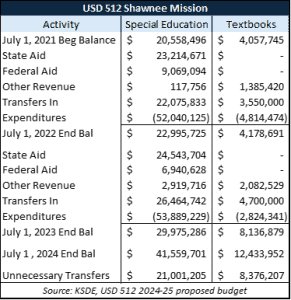Shawnee Mission school board members are pondering whether it is equitable to allow community-funded employees since most of the money comes from parents in wealthier neighborhoods, and some board members won’t let facts get in the way of their story.
According to reporting by KSHB 41, Board president Mary Sinclair offered at least two whoppers.
“Community-funded positions aren’t frivolous, but rather back-filling critical support for struggling students,” said Mary Sinclair, SMSD board president, “Aides, interventionists, the state doesn’t provide — we’re talking about schools that don’t meet that threshold.
Sinclair knows the state provides money and school boards make the spending decisions, but she tries to blame legislators for her and other board members’ decisions.
She also blamed legislators for underfunding schools over the years, telling KSHB the district is still dealing with financial chaos that dates back to 2009. That takes a lot of hutzpah, considering that Shawnee Mission isn’t spending all the funds it receives.
Positions that USD 512 must believe are more important than “critical support for struggling students”
Budgets are supposed to reflect a school board’s priorities, so it stands to reason that the Shawnee Mission finds more value in funding some positions than in what Sinclair calls “critical support for struggling students.”
Shawnee Mission spent over $500,000 on six Administrative Interns last year. It has a four-person Communications team that costs more than $400,000. The Customer Service Director was paid $122,000 (who are the customers, if not students?).
Almost $250,000 was spent on a four-person TV Production unit. A groundkeeper earned more than $100,000, and almost 30 people with ‘custodian’ in their title earned more than $50,000.

It’s not that some of these positions shouldn’t exist, but how does a district struggling to attract teachers justify paying so many employees a lot more than some teachers?
Knowing how most government budgets are built, the board and district management probably don’t look for opportunities of this nature to reallocate resources in students’ best interests. They should be, and in fact, are legally required to do so by the building needs assessment law.
Reallocating staff is just one foregone opportunity to improve student outcomes.
Shawnee Mission builds cash reserves rather than fund needed positions
On July 1, 2021, the district had $39.8 million in operating cash reserves, which excluded federal funds, capital outlay, and debt service. The district’s proposed budget says operating balances reached $84.4 million on July 1, 2024. The $44.6 million increase in operating reserves over the last three years means Sinclair and fellow board members didn’t spend all of the state and local tax money they received. Do they not understand that basic accounting function, or is Sinclair offering excuses, hoping not to get caught?
 Some of the cash reserve increases are in funds with spending restrictions. However, those balances grew because Shawnee Mission transferred too much money into the funds rather than spending it on, say, community-funded positions.
Some of the cash reserve increases are in funds with spending restrictions. However, those balances grew because Shawnee Mission transferred too much money into the funds rather than spending it on, say, community-funded positions.
Activity in the Special Education and Textbook funds are two examples. Once money enters those funds, it can only be used for the specified purpose. Special Education had a beginning fund balance of $20.6 million on July 1, 2021, and an ending balance of $23 million. The district transferred $22.1 million from other funds – all discretionary money that could have been used for something else. It could have transferred $2.4 million less and finished the year with the same cash reserve as at the beginning of the year.
The reserve balance increased from $23 million to $30 million during the 2023 school year, so the district could have transferred $7 million less and used that for other purposes. Account activity for the 2024 school year is not yet available, but the $10.6 million increase in the reserve balance found in the district’s 2024-25 proposed budget also represents an unnecessary diversion of discretionary spending.
The Textbook fund shows a cash reserve increase of $8.4 million over the last three years. It’s possible that the district is setting money aside for a very large purchase in the future, but it never spent more than $4 million out of the Textbook fund over the last ten years. Even if a large purchase is planned in a few years, setting money aside now is of no value to students struggling to read today.
What’s more, money need not be set aside to make purchases; discretionary money can be used in the year of purchase.
The Kansas Department of Education says money can be spent out of any fund and charged to a fund such as Special Education. The cash needs to exist somewhere, but it can reside in a non-restricted fund for maximum flexibility. In fact, 11 districts finished the 2023 school year with zero cash reserves for Special Education, and another 56 districts had less than $100,000 set aside.
Conclusion
Sadly, this all comes as no surprise for Shawnee Mission or the education system writ large. Student achievement will not get anywhere close to where the community wants it until the adults running the system change their behaviors, and most of them steadfastly refuse to change.


